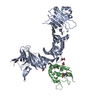[English] 日本語
 Yorodumi
Yorodumi- EMDB-21898: CryoEM structure of the C. sordellii lethal toxin TcsL in complex... -
+ Open data
Open data
- Basic information
Basic information
| Entry | Database: EMDB / ID: EMD-21898 | ||||||||||||
|---|---|---|---|---|---|---|---|---|---|---|---|---|---|
| Title | CryoEM structure of the C. sordellii lethal toxin TcsL in complex with SEMA6A | ||||||||||||
 Map data Map data | |||||||||||||
 Sample Sample |
| ||||||||||||
 Keywords Keywords | cryoEM / signaling protein-toxin complex | ||||||||||||
| Function / homology |  Function and homology information Function and homology informationnegative regulation of cell adhesion involved in sprouting angiogenesis / negative regulation of sprouting angiogenesis / semaphorin receptor binding / negative regulation of vascular endothelial growth factor signaling pathway / Other semaphorin interactions / positive regulation of neuron migration / chemorepellent activity / neural crest cell migration / Transferases; Glycosyltransferases; Hexosyltransferases / host cell cytosol ...negative regulation of cell adhesion involved in sprouting angiogenesis / negative regulation of sprouting angiogenesis / semaphorin receptor binding / negative regulation of vascular endothelial growth factor signaling pathway / Other semaphorin interactions / positive regulation of neuron migration / chemorepellent activity / neural crest cell migration / Transferases; Glycosyltransferases; Hexosyltransferases / host cell cytosol / glycosyltransferase activity / semaphorin-plexin signaling pathway / cellular response to vascular endothelial growth factor stimulus / cytoskeleton organization / cysteine-type peptidase activity / axon guidance / negative regulation of angiogenesis / host cell endosome membrane / animal organ morphogenesis / negative regulation of ERK1 and ERK2 cascade / nervous system development / toxin activity / cell surface receptor signaling pathway / axon / apoptotic process / host cell plasma membrane / extracellular region / metal ion binding / membrane / plasma membrane Similarity search - Function | ||||||||||||
| Biological species |  Homo sapiens (human) / Homo sapiens (human) /  Paeniclostridium sordellii (bacteria) Paeniclostridium sordellii (bacteria) | ||||||||||||
| Method | single particle reconstruction / cryo EM / Resolution: 3.3 Å | ||||||||||||
 Authors Authors | Kucharska I / Rubinstein JL | ||||||||||||
| Funding support |  Canada, 3 items Canada, 3 items
| ||||||||||||
 Citation Citation |  Journal: Cell / Year: 2020 Journal: Cell / Year: 2020Title: Recognition of Semaphorin Proteins by P. sordellii Lethal Toxin Reveals Principles of Receptor Specificity in Clostridial Toxins. Authors: Hunsang Lee / Greg L Beilhartz / Iga Kucharska / Swetha Raman / Hong Cui / Mandy Hiu Yi Lam / Huazhu Liang / John L Rubinstein / Daniel Schramek / Jean-Philippe Julien / Roman A Melnyk / Mikko Taipale /  Abstract: Pathogenic clostridial species secrete potent toxins that induce severe host tissue damage. Paeniclostridium sordellii lethal toxin (TcsL) causes an almost invariably lethal toxic shock syndrome ...Pathogenic clostridial species secrete potent toxins that induce severe host tissue damage. Paeniclostridium sordellii lethal toxin (TcsL) causes an almost invariably lethal toxic shock syndrome associated with gynecological infections. TcsL is 87% similar to C. difficile TcdB, which enters host cells via Frizzled receptors in colon epithelium. However, P. sordellii infections target vascular endothelium, suggesting that TcsL exploits another receptor. Here, using CRISPR/Cas9 screening, we establish semaphorins SEMA6A and SEMA6B as TcsL receptors. We demonstrate that recombinant SEMA6A can protect mice from TcsL-induced edema. A 3.3 Å cryo-EM structure shows that TcsL binds SEMA6A with the same region that in TcdB binds structurally unrelated Frizzled. Remarkably, 15 mutations in this evolutionarily divergent surface are sufficient to switch binding specificity of TcsL to that of TcdB. Our findings establish semaphorins as physiologically relevant receptors for TcsL and reveal the molecular basis for the difference in tissue targeting and disease pathogenesis between highly related toxins. | ||||||||||||
| History |
|
- Structure visualization
Structure visualization
| Movie |
 Movie viewer Movie viewer |
|---|---|
| Structure viewer | EM map:  SurfView SurfView Molmil Molmil Jmol/JSmol Jmol/JSmol |
| Supplemental images |
- Downloads & links
Downloads & links
-EMDB archive
| Map data |  emd_21898.map.gz emd_21898.map.gz | 7.3 MB |  EMDB map data format EMDB map data format | |
|---|---|---|---|---|
| Header (meta data) |  emd-21898-v30.xml emd-21898-v30.xml emd-21898.xml emd-21898.xml | 13.6 KB 13.6 KB | Display Display |  EMDB header EMDB header |
| Images |  emd_21898.png emd_21898.png | 48.3 KB | ||
| Filedesc metadata |  emd-21898.cif.gz emd-21898.cif.gz | 6.3 KB | ||
| Archive directory |  http://ftp.pdbj.org/pub/emdb/structures/EMD-21898 http://ftp.pdbj.org/pub/emdb/structures/EMD-21898 ftp://ftp.pdbj.org/pub/emdb/structures/EMD-21898 ftp://ftp.pdbj.org/pub/emdb/structures/EMD-21898 | HTTPS FTP |
-Validation report
| Summary document |  emd_21898_validation.pdf.gz emd_21898_validation.pdf.gz | 452.6 KB | Display |  EMDB validaton report EMDB validaton report |
|---|---|---|---|---|
| Full document |  emd_21898_full_validation.pdf.gz emd_21898_full_validation.pdf.gz | 452.2 KB | Display | |
| Data in XML |  emd_21898_validation.xml.gz emd_21898_validation.xml.gz | 4.6 KB | Display | |
| Data in CIF |  emd_21898_validation.cif.gz emd_21898_validation.cif.gz | 5.2 KB | Display | |
| Arichive directory |  https://ftp.pdbj.org/pub/emdb/validation_reports/EMD-21898 https://ftp.pdbj.org/pub/emdb/validation_reports/EMD-21898 ftp://ftp.pdbj.org/pub/emdb/validation_reports/EMD-21898 ftp://ftp.pdbj.org/pub/emdb/validation_reports/EMD-21898 | HTTPS FTP |
-Related structure data
| Related structure data |  6wtsMC C: citing same article ( M: atomic model generated by this map |
|---|---|
| Similar structure data |
- Links
Links
| EMDB pages |  EMDB (EBI/PDBe) / EMDB (EBI/PDBe) /  EMDataResource EMDataResource |
|---|---|
| Related items in Molecule of the Month |
- Map
Map
| File |  Download / File: emd_21898.map.gz / Format: CCP4 / Size: 7.8 MB / Type: IMAGE STORED AS FLOATING POINT NUMBER (4 BYTES) Download / File: emd_21898.map.gz / Format: CCP4 / Size: 7.8 MB / Type: IMAGE STORED AS FLOATING POINT NUMBER (4 BYTES) | ||||||||||||||||||||||||||||||||||||||||||||||||||||||||||||||||||||
|---|---|---|---|---|---|---|---|---|---|---|---|---|---|---|---|---|---|---|---|---|---|---|---|---|---|---|---|---|---|---|---|---|---|---|---|---|---|---|---|---|---|---|---|---|---|---|---|---|---|---|---|---|---|---|---|---|---|---|---|---|---|---|---|---|---|---|---|---|---|
| Projections & slices | Image control
Images are generated by Spider. generated in cubic-lattice coordinate | ||||||||||||||||||||||||||||||||||||||||||||||||||||||||||||||||||||
| Voxel size | X=Y=Z: 1.03 Å | ||||||||||||||||||||||||||||||||||||||||||||||||||||||||||||||||||||
| Density |
| ||||||||||||||||||||||||||||||||||||||||||||||||||||||||||||||||||||
| Symmetry | Space group: 1 | ||||||||||||||||||||||||||||||||||||||||||||||||||||||||||||||||||||
| Details | EMDB XML:
CCP4 map header:
| ||||||||||||||||||||||||||||||||||||||||||||||||||||||||||||||||||||
-Supplemental data
- Sample components
Sample components
-Entire : Complex of SEMA6A with TcsL
| Entire | Name: Complex of SEMA6A with TcsL |
|---|---|
| Components |
|
-Supramolecule #1: Complex of SEMA6A with TcsL
| Supramolecule | Name: Complex of SEMA6A with TcsL / type: complex / ID: 1 / Parent: 0 / Macromolecule list: #1-#2 |
|---|
-Supramolecule #2: SEMA6A
| Supramolecule | Name: SEMA6A / type: complex / ID: 2 / Parent: 1 / Macromolecule list: #1 |
|---|---|
| Source (natural) | Organism:  Homo sapiens (human) Homo sapiens (human) |
-Supramolecule #3: TcsL
| Supramolecule | Name: TcsL / type: complex / ID: 3 / Parent: 1 / Macromolecule list: #2 |
|---|---|
| Source (natural) | Organism:  Paeniclostridium sordellii (bacteria) Paeniclostridium sordellii (bacteria) |
-Macromolecule #1: SEMA6A
| Macromolecule | Name: SEMA6A / type: protein_or_peptide / ID: 1 / Number of copies: 2 / Enantiomer: LEVO |
|---|---|
| Source (natural) | Organism:  Homo sapiens (human) Homo sapiens (human) |
| Molecular weight | Theoretical: 63.85741 KDa |
| Recombinant expression | Organism:  Homo sapiens (human) Homo sapiens (human) |
| Sequence | String: ETGFPEDSEP ISISHGNYTK QYPVFVGHKP GRNTTQRHRL DIQMIMIMNG TLYIAARDHI YTVDIDTSHT EEIYCSKKLT WKSRQADVD TCRMKGKHKD ECHNFIKVLL KKNDDALFVC GTNAFNPSCR NYKMDTLEPF GDEFSGMARC PYDAKHANVA L FADGKLYS ...String: ETGFPEDSEP ISISHGNYTK QYPVFVGHKP GRNTTQRHRL DIQMIMIMNG TLYIAARDHI YTVDIDTSHT EEIYCSKKLT WKSRQADVD TCRMKGKHKD ECHNFIKVLL KKNDDALFVC GTNAFNPSCR NYKMDTLEPF GDEFSGMARC PYDAKHANVA L FADGKLYS ATVTDFLAID AVIYRSLGES PTLRTVKHDS KWLKEPYFVQ AVDYGDYIYF FFREIAVEYN TMGKVVFPRV AQ VCKNDMG GSQRVLEKQW TSFLKARLNC SVPGDSHFYF NILQAVTDVI RINGRDVVLA TFSTPYNSIP GSAVCAYDML DIA SVFTGR FKEQKSPDST WTPVPDERVP KPRPGCCAGS SSLERYATSN EFPDDTLNFI KTHPLMDEAV PSIFNRPWFL RTMV RYRLT KIAVDTAAGP YQNHTVVFLG SEKGIILKFL ARIGNSGFLN DSLFLEEMSV YNSEKCSYDG VEDKRIMGMQ LDRAS SSLY VAFSTCVIKV PLGRCERYGK CKKTCIASRD PYCGWIKEGG ACSHLSPNSR LTFEQDIERG NTDGLGDCHN GSWSHP QFE K UniProtKB: Semaphorin-6A |
-Macromolecule #2: TcsL
| Macromolecule | Name: TcsL / type: protein_or_peptide / ID: 2 / Number of copies: 1 / Enantiomer: LEVO EC number: Transferases; Glycosyltransferases; Hexosyltransferases |
|---|---|
| Source (natural) | Organism:  Paeniclostridium sordellii (bacteria) Paeniclostridium sordellii (bacteria) |
| Molecular weight | Theoretical: 63.315875 KDa |
| Recombinant expression | Organism:  |
| Sequence | String: SAWSHPQFEK ENLYFQGTNV RINLDGNTRS FIVPVITTEQ IRKNLSYSFY GSGGSYSLSL SPYNMNIDLN LVENDTWVID VDNVVKNIT IESDEIQKGE LIENILSKLN IEDNKIVLNN HTINFYGAIN ESNRFISLTF SILEDINIII EIDLVSKSYK I LLSGNCIK ...String: SAWSHPQFEK ENLYFQGTNV RINLDGNTRS FIVPVITTEQ IRKNLSYSFY GSGGSYSLSL SPYNMNIDLN LVENDTWVID VDNVVKNIT IESDEIQKGE LIENILSKLN IEDNKIVLNN HTINFYGAIN ESNRFISLTF SILEDINIII EIDLVSKSYK I LLSGNCIK LIENSSDIQQ KIDHIGFNGE HQKYIPYSYI DNETKYNGFI DYSKKEGLFT AEFSNESIIR NIYMPDSNNL FI YSSKDLK DIRIINKGDV KLLIGNYFKD NMKVSLSFTI EDTNTIKLNG VYLDENGVAQ ILKFMNNAKS ALNTSNSLMN FLE SINIKN IFYNNLDPNI KFILDTNFII SGSNSIGQFE LICDKDKNIQ PYFIKFKIKE TSYTLYAGNR QNLIVEPSYH LDDS GNISS TVINFSQKYL YGIDRYVNKV IITPNLYTDE INITPVYKPN YICPEVIILD ANYINEKINI NINDLSIRYV WDNDG SDLI LIANSEEDNQ PQVKIRFVNV FKSDTAADKL SFNFSDKQDV SVSKIISTFS LAAGSENLYF QGHHHHHH UniProtKB: Lethal Toxin |
-Macromolecule #4: 2-acetamido-2-deoxy-beta-D-glucopyranose
| Macromolecule | Name: 2-acetamido-2-deoxy-beta-D-glucopyranose / type: ligand / ID: 4 / Number of copies: 4 / Formula: NAG |
|---|---|
| Molecular weight | Theoretical: 221.208 Da |
| Chemical component information |  ChemComp-NAG: |
-Experimental details
-Structure determination
| Method | cryo EM |
|---|---|
 Processing Processing | single particle reconstruction |
| Aggregation state | particle |
- Sample preparation
Sample preparation
| Concentration | 0.9 mg/mL |
|---|---|
| Buffer | pH: 7 |
| Vitrification | Cryogen name: ETHANE-PROPANE |
- Electron microscopy
Electron microscopy
| Microscope | FEI TITAN KRIOS |
|---|---|
| Image recording | Film or detector model: OTHER / Average electron dose: 45.24 e/Å2 / Details: Dataset was collected with FEI Falcon IV. |
| Electron beam | Acceleration voltage: 300 kV / Electron source:  FIELD EMISSION GUN FIELD EMISSION GUN |
| Electron optics | Illumination mode: FLOOD BEAM / Imaging mode: BRIGHT FIELD |
| Experimental equipment |  Model: Titan Krios / Image courtesy: FEI Company |
- Image processing
Image processing
| Startup model | Type of model: PDB ENTRY PDB model - PDB ID: |
|---|---|
| Final reconstruction | Applied symmetry - Point group: C1 (asymmetric) / Resolution.type: BY AUTHOR / Resolution: 3.3 Å / Resolution method: FSC 0.143 CUT-OFF / Number images used: 179188 |
| Initial angle assignment | Type: NOT APPLICABLE |
| Final angle assignment | Type: NOT APPLICABLE |
 Movie
Movie Controller
Controller


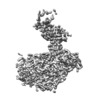


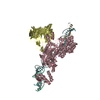
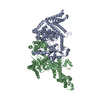

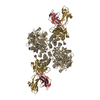





 X (Sec.)
X (Sec.) Y (Row.)
Y (Row.) Z (Col.)
Z (Col.)





















